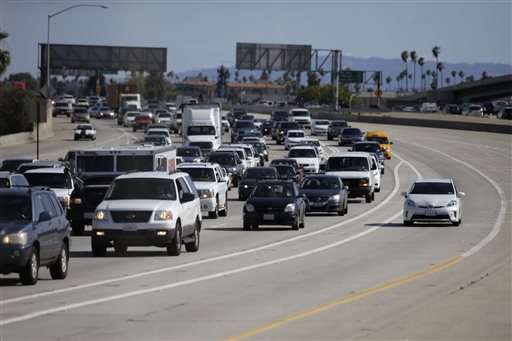Avoiding future freeway congestion could come with a cost

Fewer of tomorrow's freeways will be free. In exchange, drivers willing and able to pay will avoid the traffic congestion that bedevils everyone else.
Toll lanes are an increasingly common solution in metropolitan regions with limited public space or money to widen highways. One increasingly popular idea is to convert carpool lanes to let solo drivers pay for a faster ride. In the future, non-carpool lanes might also be tolled.
That's just one approach transportation planners are taking as they try to ease the nation's deepening traffic congestion. With little hope that the federal government will splurge on enough new construction to reverse traffic trends, the goal is to squeeze as much efficiency as possible out of current highways.
Other possibilities are more complex and would take longer. They include substituting the federal gas tax for a charge on each mile driven, adopting technology that will let vehicles communicate with each other and the roads, and developing self-driving cars that could speed along with just the smallest of gaps between them.
Perhaps the most ambitious highway-conversion plan is in the San Francisco Bay Area, where hills and the namesake body of water are natural barriers to mobility. Regional transportation planners are sketching out a future network of 550 miles of toll lanes on existing highways that should give paying drivers a reliably faster commute, whether they drive alone or carpool.
The concept in counties east and south of San Francisco is to convert carpool lanes to so-called "high-occupancy toll" lanes that solo drivers could use if they have a transponder that tracks their mileage and bills them accordingly.
In the future, the project could turn freeway lanes that don't now require carpooling into toll lanes, said Melanie Crotty, director of operations at the Metropolitan Transportation Commission, which oversees planning in the nine-county region. Converting "general purpose" lanes into toll lanes would require a change in state law—and presumably face public opposition—but the option is real.
Hundreds of miles of toll lanes already operate around Los Angeles, Houston, Atlanta, Miami, Salt Lake City, Washington and other major cities. New or expanded ones are planned for Tampa, Orlando, Dallas, the Baltimore area and Austin, Texas.
"Imagine driving 50 mph or faster without any stop-and-go driving or rush-hour gridlock," promises the website of the Dallas-area TEXpress Lanes.
Under federal rules, carpool lanes that are converted to toll lanes must have speeds averaging at least 45 mph during 90 percent of morning and evening commutes. To limit crowding, tolls rise during periods of heavy congestion.
Charging money for the privilege of avoiding traffic jams is not without its critics. They say the public already paid for the lanes and that they amount to "Lexus lanes," reserved only for those who can afford them.
Supporters counter that those using the toll lanes are people who need to get somewhere on time, whether it's an hourly worker at the mall or a delivery service, and that traffic is too bad not to take advantage of the extra space.
Discover the latest in science, tech, and space with over 100,000 subscribers who rely on Phys.org for daily insights. Sign up for our free newsletter and get updates on breakthroughs, innovations, and research that matter—daily or weekly.
Another approach to raising money for road maintenance and construction is charging fees based on the number of miles driven.
Currently, governments raise billions of dollars annually through gas taxes. But the federal tax has not changed in decades, and with vehicles becoming more fuel-efficient, drivers don't fill up as often. As a result, the amount of highway money Washington sends to the states is flat.
Oregon is a pioneer in use charges. On July 1, the state begins its third pilot program in which 5,000 volunteers will be charged 1.5 cents per mile they drive. In return, they will be refunded gas taxes.
While the goal is to raise enough money to keep Oregon's highways in good repair, the state doesn't plan to profit yet. For now, the idea is to explore a potential alternative to the gas tax. Vehicle mileage would be tracked by a device plugged into each car.
Once implemented, the pricing schemes could take into account time of day, whether the miles were city or rural, even the type of vehicle and thus how much it could damage the road, said Naveen Lamba, a program manager for smart infrastructure at the engineering consultancy CH2M.
Other states that have explored charging drivers by the mile include California, Florida, Illinois, Washington, Nevada and Delaware.
And then there are the next-generation technologies.
Those include "vehicle-to-vehicle" systems that will let vehicles communicate with each other, as well as with traffic lights and other infrastructure. Connecting cars in this way would create a rolling, real-time traffic intelligence network: Cars could inform one another of an accident ahead, for example, and the car could suggest a detour to its driver.
Or, if the car is self-driving, it could just reroute itself.
These vehicles of the future are still being tested. Because they wouldn't get distracted, drunk or sleepy—and on-board sensors could see much farther than drivers—the idea is that they would be better drivers than people.
After all, their boosters point out, human error causes most accidents, and eliminating most accidents would go a long way toward the smoother flow of traffic.
© 2015 The Associated Press. All rights reserved.




















